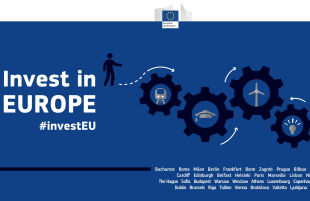Analytics, EU – Baltic States, Investments, Legislation, Markets and Companies
International Internet Magazine. Baltic States news & analytics
Wednesday, 25.06.2025, 10:57
The EU plan for strategic investment is extended beyond 2018
 Print version
Print version
It is about eighteen months since Commission President Jean-Claude Juncker launched the Investment Plan for Europe and a year after the start of the European Fund for Strategic Investments (EFSI). The Commission analyses the achievements gained: thus, the Commission President shared the lessons learned and made some proposals for the EFSI’s ambitious future. He underlined that the Investment Plan and the EFSI had been of great help in creating jobs and triggering investments in the real economy: due to real success, the Commission proposed to extend both “instruments” beyond 2018.
Achievements to date
 |
|---|
Commission Vice-President Jyrki Katainen, responsible for Jobs, Growth, Investment and Competitiveness, added that the EU together with the EIB achieved a lot in the past 12 months: both supported innovative energy projects, healthcare centres, urban development and high-speed broadband, to name a few.
There are numerous positive examples:
= about 150,000 SMEs in Europe have access to new financing;
= the Commission has created a hub which provided advisory services and technical support to project promoters;
= a new portal for promoters was launched to showcase their projects worldwide to investors. However, there is more to be done: the single market must be continuingly and the EU-28 unique member states’ “market place” must remove existing barriers to investment.
The European Fund for Strategic Investments (EFSI) being the heart of this Commission's Investment Plan, is managed by the EIB Group; it helps to deliver on mobilising at least € 315 billion in additional investments in the member states’ real economy by mid-2018. The EFSI provides a first loss guarantee, so that the EIB has been able to invest in more projects, sometimes riskier projects, and to invest sooner than without the EFSI.
Overall, the EFSI is already active in 26 EU states and is expected to trigger € 100 billion in investment with the approvals given so far. The SMEs have benefited particularly from the EFSI so far; the EIB and the Commission will increase their local outreach to encourage more EFSI activity in the EU states. See: http://europa.eu/rapid/press-release_IP-16-1933_en.htm.
Besides, the Commission officially launched another element of the Investment Plan (on 1st June 2016), the European Investment Project Portal (EIPP), an online platform bringing together European project promoters and investors from the EU and beyond. The Portal will increase the visibility of projects to invest in across Europe; EU investors asked for it and the Commission delivered.
Another investment instrument – the European Investment Advisory Hub (EIAH) – provides technical assistance and tailored advice to private and public project promoters. The Hub has already dealt with more than 160 requests. Whilst this is a promising start, the Commission and EIB are working on making the advisory services more local and closer to those companies that should benefit.
In February 2016, the Commission issued guidance on how European Structural and Investment Funds (ESI Funds) can be combined with the EFSI to enable as much investment as possible. A first set of projects is already benefiting from this combination in practice which will be further simplified.
Finally, the Commission has already taken a number of steps to improve the business environment and financing conditions as part of the Investment Plan's third pillar. Initiatives include lowering capital charges for insurance and reinsurance companies. Insurers told the Commission that some of the Solvency II rules were keeping them from investing in infrastructure, and now this obstacle has been removed. The Commission will evaluate whether it is appropriate to lower bank capital charges for infrastructure exposures in a similar way, taking into account discussions on capital treatment of bank exposures. To facilitate venture capital investment in Europe, the Commission will also propose some changes to the venture capital regulatory framework. Together with Eurostat, the Commission will provide further clarity and review, where appropriate, relevant guidance as regards accounting aspects of public-private partnerships. To offer further legal certainty to investors as regards the financing of infrastructure, the Commission has provided practical guidance on what constitutes State aid, in the form of a Communication on the Notion of State aid.
Recent Communication on Delivering the Single Market Agenda also outlines the many strands of work that have been or will be carried out at EU level to create a business-friendly environment to encourage innovation and invest in people. This work ranges from creating a Digital Single Market, making the market without borders for services a reality, simplifying VAT rules, to improving access to venture capital for start-ups and investing in skills.
The Commission is also working with the European Investment Fund (EIF) to establish a Pan-European Venture Capital Fund-of-Funds that would combine public finance and private capital for additional stimulus and scale for new companies. However, the EU member states also need to continue their structural reforms to remove bottlenecks and red-tape which act as a barrier to investment.
The future of the EFSI
Building on these positive results, the Commission proposes the following way forward.
· Reflecting on its success so far, a reinforced EFSI will continue beyond the initial three-year period to address remaining market gaps and failures and continue to mobilise private sector financing in investments crucial for Europe's future job creation, growth and competitiveness, with strengthened "additionality". The Commission will present legislative proposals in autumn 2016 to extend the duration of the EFSI, bearing in mind the scarcity of budgetary resources.
· One of the biggest success stories of the EFSI has been the strong interest and participation by intermediary banks across the EU to provide finance to SMEs, the so-called EFSI SME-window. This will be scaled up quickly, under the current framework, for the benefit of SMEs and mid-cap companies in all EU states. The Commission will work with the EFSI Steering Board to use all the existing possibilities under the EFSI Regulation to reinforce the SME window.
· The Commission will explore the possibility of using an EFSI-type model for investments in developing third countries.
· The combination of EFSI support and ESI Funds will be further simplified and legislative and other obstacles to such combinations removed.
· The Advisory Hub will be enhanced to be able to work more locally and to enhance its work with National Promotional Banks.
· Establishing Investment Platforms will be further encouraged, with strong engagement from the Commission, the EIB Group, National Promotional Banks and other relevant actors. This is particularly important for small projects to reach scale.
· Energy efficiency is undoubtedly one of the most successful sectors under the EFSI. The EFSI will continue to contribute to the development of the market for sustainable/green projects, by encouraging the development of a green bond market in Europe and improved coordination of existing efforts.
· The Commission will continue to deliver on its Single Market priorities. Together with Eurostat, the Commission will provide further clarity and review, where appropriate, relevant guidance as regards accounting aspects of public-private partnerships.
· The EU states should also establish clear priorities, prepare concrete investment projects with the help of the Advisory Hub – in particular on cross-border projects – and structure their projects in an optimal way to ensure a greater use of financial instruments. In the context of the European Semester process, the EU states should implement the country-specific recommendations to address national barriers to investment.
More information:
· For more information, see Memo.
· For the full list of projects approved for financing under the EFSI, click here.
· For the full lists of SME agreements approved for financing under the EFSI, click here.
· For the latest EFSI figures including a break-down by sector and by country click here.
· For more information about the Investment Plan in general, see the FAQs.








 «The Baltic Course» Is Sold and Stays in Business!
«The Baltic Course» Is Sold and Stays in Business!

